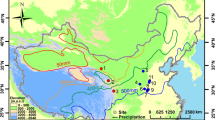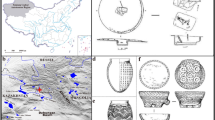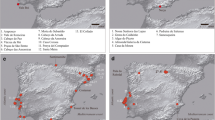Abstract
Historical records and archaeological remains indicate that the Chinese agricultural economy changed significantly from the Warring States (475–221 BC) to Han Dynasties (206 BC-220 AD), i.e., from rice-millet based agriculture to rice-millet-wheat based agriculture. However, the variation of human diets and the inner relationship between human diets and the agricultural transition during this period remain poorly understood. In this paper, the C and N stable isotopes from human and animal bones at the Shenmingpu site (SMPS), Xichuan County, Henan Province were analyzed. If some outliers (M34, M36, M102) were excluded, the mean δ 13C value ((−16.7±0.8)‰, n=15) of humans in Han Dynasties was dramatically lower than that in the Warring States ((−12.7±0.8)‰, n=14), indicating that the cultivation of rice and wheat, especially wheat, had been more widely popularized in Han Dynasties. Meanwhile, the range of δ 15N values of humans (6.6‰–9.3‰) in Han Dynasties was narrower than that of the Warring States (6.2‰–10.4‰), suggesting that the animal protein resources in human foods during Han Dynasties were more concentrated. The transition of human diets and the close relationship with the change of agricultural economy in SMPS were due to more stable society, the carryout of new agricultural policies, and the emergence of new agricultural tools in Han Dynasties
Similar content being viewed by others
References
Zhang B, Fan Z M. Chinese Agricultural History—The Volume of Warring States, Qin and Han Dynasties (in Chinese). Beijing: China Agriculture Press, 2007. 1–173
Xu Z Y. The Agriculture of Han Dynasties-The Formation of Chinese Agricultural Economy and Its’ Characteristics (in Chinese). Nanjing: Jiangsu People’s Publishing Ltd, 1998. 1–12
Zhou C Z, Qi R D. The Mozi: A Complete Translation (in Chinese). Guiyang: Guizhou People’s Publishing House, 1995. 60
Yang B J. The Collation and Annotation of Mencius (in Chinese). Beijing: Zhonghua Book Company, 1960. 311
Zhou Z F. The Collation and Annotation of Shijing (The Book of Songs) (in Chinese). Beijing: Zhonghua Book Company, 2002. 76
Wang L Q. The Collation and Annotation of Fengsutongyi (General Introduction to Customs) (in Chinese). Beijing: Zhonghua Book Company, 1981. 356
Zhang S D. The Collation and Annotation of Huainanzi (in Chinese). Beijing: Peking University Press, 1997. 580
Ban G. Hanshu (in Classical Chinese). Beijing: Zhonghua Book Company, 1962. 1695
Luoyang Museum. Excavation of the Zhan’guo liangcang site in Luoyang (in Chinese). Cultural Relics, 1981, (11): 55–65
Xinzheng workstation of Henan Museum, Xinzheng Museum. Prospection and excavation of the Zhenghan Gucheng site in Xinzheng, Henan (in Chinese). In: The Committee of Cultural Compilation, eds. The Series Journal of Cultural Data, 3rd Ser. Beijing: The Cultural Relics Publishing House, 1980. 56–66
Cha R Z. Archaeology of the Warring States, Qin and Han Dynasties (in Chinese). Nanjing: Nanjing University Press, 1990. 21–32
Li F L. Archaeology of the Warring States, Qin and Han Dynasties (in Chinese). Ji’nan: Shandong University Press, 1990. 10–11
Hubei Museum. Prospection and excavation of the Ji’nancheng site (in Chinese). Acta Archaeol Sin, 1982, (4): 477–508
The Writing Group of Shuihudi Qin Tombs in Yunmeng. Shuihudi Qin Tombs in Yunmeng (in Chinese). Beijing: The Cultural Relics Publishing House, 1981. 58–62
The Commission for the Archaeological Excavation, Houma. Excavation of the Eastern Zhou site in the south Gucheng of of Niu village in Houma (in Chinese). Archaeology, 1962, (2): 55–62
He G B. Tomb 81 of the Han period in Laocheng Xijiao, Luoyang (in Chinese). Archaeology, 1964, (8): 403–406
The Archaeological Team, Luoyang. Excavation of the tomb 11 of the Han period at Jin’guyuan station, in Luoyang city (in Chinese). Cultural Relics, 1983, (4): 15–28
Hubei Provincial Institute of Cultural Relics and Archaeology. Tomb 168 of the Han period at Fenghuangshan, Jiangling (in Chinese). Ar chaeology, 1993, (4): 455–513
Hunan Museum, Institute of Archaeology, Chinese Academy of Social Sciences. Tomb 1 of the Han period at Mawangdui (in Chinese). Beijing: The Cultural Relics Publishing House, 1973. 111–112
Chen W H, Zhang Z K. Archaeological data index of Chinese ancient agricultural crops (in Chinese). Agricul Archaeol, 1987, (1): 413–425
Chen D R. An overview about Barn can (in Chinese). Agricul Archaeol, 1987, (2): 279–285
Lin Z T. Studies on the portrait of brick and stone to obverse the characteristics of agricultural economic in Han Dynasties (in Chinese). Agricul Archaeol, 1996, (1): 38–42
Li F L. A trial discussion on the rotational grinder in ancient China (in Chinese). Agricul Archaeol, 1986, (2): 146–167
Institute of Archaeology, Chinese Academy of Social Sciences, The Commission for the Preservation of Ancient Monuments, Heibei province. Excavation of Mancheng Tomb (in Chinese). Beijing: The Cultural Relics Publishing House, 1980. 106
National Museum of Chinese History. Concise Historical Atlas of China (in Chinese). Volume IV. Tianjin: Tianjin People’s Arts Publishing House, 1979. 80
Xiangfen Museum. The iron tools of the Han period found in Xiangfen, Shanxi (in Chinese). Archaeology, 1978, (2): 141–142
Huang Z Y. Excavations of Eastern part of the Han Town of Ho-nan Hsien at Luoyang, 1955 (in Chinese). Acta Archaeol Sin, 1956, (4): 21–54
Geng Q Y, Cai X W. Stone grinders of the Western Han period found in Hongxian, Henan (in Chinese). Archaeology, 1983, (10): 949
The Commission for the Preservation of Ancient Monuments, Gansu Province. The important cultural relics discovered by the Archaeological Team of the Lanzhou-Xinjiang Railway at Heisongyi site, Gulang (in Chinese). Ref Cultural Data, 1954, (2): 105–106
Richards M P. A brief review of the archaeological evidence for Palaeolithic and Neolithic subsistence. Eur J Clin Nutr, 2002, 56: 1270–1278
Zhang X L, Wang J X, Xian Z Q, et al. Studies on ancient human diet (in Chinese). Archaeology, 2003, (2): 62–75
Fu Q M, Jin S A, Hu Y W, et al. Agricultural development and human diets in Gouwan site, Xichuan, Henan. Chin Sci Bull, 2010, 55: 614–620
Guo Y, Hu Y W, Zhu J Y, et al. Stable carbon and nitrogen isotope evidence of human and pig diets at the Qinglongquan site, China. Sci China Ser D-Earth Sci, 2011, 54: 519–527
O’Leary M H. Carbon isotope fractionation in plants. Photochemistry, 1981, 20: 553–567
Ambrose S H, Norr L. Isotopic composition of dietary protein and energy versus bone collagen and apatite: Purified diet growth experiments. In: Lambert J B, Grupe G, eds. Molecular Archaeology of Prehistoric Human Bone (Prehistoric Human Bone-Archaeology at the Molecular Level). Berlin: Springer, 1993. 1–37
Zhang X L. 13C and 15N analysis applied in the study of ancient man’s diet and their new advances (in Chinese). Archaeology, 2006, (7): 50–56
Hedges R E M, Reynard L M. Nitrogen isotopes and the trophic level of humans in archaeology. J Archaeolo Sci, 2007, 34: 1240–1251
Bocherens H, Fizet M, Mariotti A. Diet, physiology and ecology of fossil mammals as inferred from stable carbon and nitrogen isotope biogenchemistry: Implications for Pleistocene bears. Palaeogeogr Palaeoclimatol Paleoecol, 1994, 107: 215–225
Hu Y W. Palaeodiet Analysis of Ancient Human and Related Studies (in Chinese). Hefei: University of Science and Technology of China, 2002. 15–16
Ambrose S H. Effects of diet, climate and physiology on nitrogen isotope abundances in terrestrial foodwebs. J Archaeol Sci, 1991, 18: 293–317
Jay M, Richards M P. Diet in the Iron Age cemetery population at Wetwang Slack, East Yorkshire, UK: Carbon and nitrogen stable isotope evidence. J Archaeolo Sci, 2006, 33: 653–662
Hedges R E M. Bone diagenesis: An overview of processes. Archaeometry, 2002, 44: 319–328
Ambrose S H, Butler B M, Hanson D H, et al. Stable isotopic analysis of human diet in the Marianas Archipelago, Western Pacific. Am J Phys Anthropol, 1997, 104: 343–361
Ambrose S H. Preparation and characterization of bone and tooth collagen for isotopic analysis. J Archaeol Sci, 1990, 17: 431–451
DeNiro M J. Post-mortem preservation of alteration of in vivo bone collagen isotope ratios in relation to palaeodietary reconstruction. Nature, 1985, 317: 806–809
Wang X G, Xu X. A discussion on the rice-millet blended zone in Neolithic Age (in Chinese). Chin Agricul His, 2003, 22: 3–9
Jin S A, Zheng W Q, Cao Y P, et al. Great achievements in the archaeological excavation of Gouwan site, in Xichuan, Nanyang City, Henan (in Chinese). China Cultural Relics News, 2009, 4: 2
The Henan Group of the Archaeological Team. The Office for Programme of the Works in the Changjiang River Valley. An excavation report of Huanglianshu site in Xichuan City, Henan (in Chinese). Huaxia Archaeol, 1990, (3): 1–69
Institute of Archaeology, Chinese Academy of Social Sciences. Qinglongquan Site and Dasi Site (in Chinese). Beijing: Science Press, 1991. 201–205
Li F. The origin and spread of Chinese normal wheat (in Chinese). World Agricul, 1980, (10): 44–62
Hu Y W, Luan F S, Wang S G, et al. Preliminary attempt to distinguish the domesticated pigs from wild boars by the methods of carbon and nitrogen stable isotope analysis. Sci China Ser D-Earth Sci, 2009, 52: 85–92
Zhu K Z. Climatic changes in the past 5000 years in China (in Chinese). Acta Archaeol Sin, 1972, (1): 20–21
The Committee of Xichuan Local Chronicles Compilation. Annals of Xichuan County (in Chinese). Zhengzhou: Henan People’s Publishing House, 1990. 60
Ma X. “Bianminqihu” and the control of population in Han Dynasties (in Chinese). Dongyue Tribune, 1996, (5): 82–88
Author information
Authors and Affiliations
Corresponding author
Rights and permissions
About this article
Cite this article
Hou, L., Wang, N., Lü, P. et al. Transition of human diets and agricultural economy in Shenmingpu Site, Henan, from the Warring States to Han Dynasties. Sci. China Earth Sci. 55, 975–982 (2012). https://doi.org/10.1007/s11430-012-4409-0
Received:
Accepted:
Published:
Issue Date:
DOI: https://doi.org/10.1007/s11430-012-4409-0




